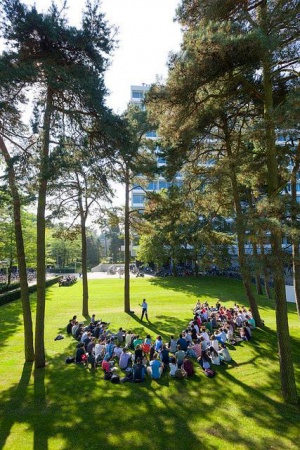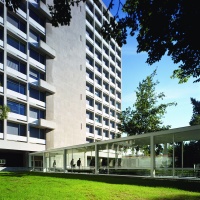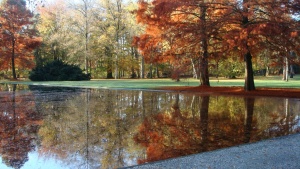Campus (English)
The Latin word campus means “expanse” or “field” and is particularly used to designate the grounds of universities that are located out of town, often in wooded areas. Many universities had their origins in inner cities but moved out when numbers of students and programs rose. This is what happened in Tilburg too, when the College in 1962 left its premises at the Bosscheweg to grow into a campus university on the verge of the Warande woods. When it opened, the campus had just one building, whereas it has 14 buildings now. The new Education and Self-Study Center (OZC) is to open its doors in 2018, and a new restaurant has been proposed on the spot of the current Warande and Prisma Buildings.
Landscape architecture
When designing the public spaces, the architect Bedaux, who designed the first three buildings on campus (the Cobbenhagen, Koopmans and Goossens Buildings), worked with Pieter Buys, garden and landscape architect. The park-like environment is an important quality of the campus, much appreciated by students and staff, as shown in questionnaires. In the last quarter of the previous century, this quality came under some pressure on the northern side, particularly due to the arrival of temporary accommodation that nonetheless stayed for decades. In a sense, the buildings also represent the spirit of the age. The temporary accommodation (the former Simon and Prisma Buildings) dates back to the late seventies, a time of economic downturn and cutbacks in higher education. Montesquieu and the Faculty Club, buildings with greater architectural merit, are the visible products of better times.
Expansion
Up until the nineties, the campus axis stretched from Buildings A and B (now Cobbenhagen and Koopmans) to the low-rise buildings housing the Social Sciences and Psychology. All this changed when the University Library, the Dante Building and the Esplanade Building arrived. This shifted the axis in a west-east direction, even more so when the University acquired more and more buildings on the other side of the Hogeschoollaan, such as the Simon Building (also designed by Bedaux), the Montesquieu Building and the Academia Building. The new principal axis of the campus even acquired a name: the Esplanade. The campus expansion in an easterly direction was necessitated by the University’s rapid growth, from 1,200 students in 1962 to well over 13,000 students in 2016. In landscape terms, this expansion was hard to integrate into the campus as there is virtually no border with trees or a water feature. With trees, paving and lighting being the same, however, the western and eastern parts are clearly connected.
The leafy character of the campus takes pride of place in the Tilburg University Masterplan, outlining developments for the next decade. This green campus is an excellent environment not only for rest and relaxation but also increasingly for reflection and study. The number of outdoor workplaces ‒ and their use ‒ is on the rise.



